 "BiTurbo228 - Dr Frankenstein of Spitfires" (biturbo228)
"BiTurbo228 - Dr Frankenstein of Spitfires" (biturbo228)
03/08/2014 at 09:53 • Filed to: None
 1
1
 32
32
 "BiTurbo228 - Dr Frankenstein of Spitfires" (biturbo228)
"BiTurbo228 - Dr Frankenstein of Spitfires" (biturbo228)
03/08/2014 at 09:53 • Filed to: None |  1 1
|  32 32 |
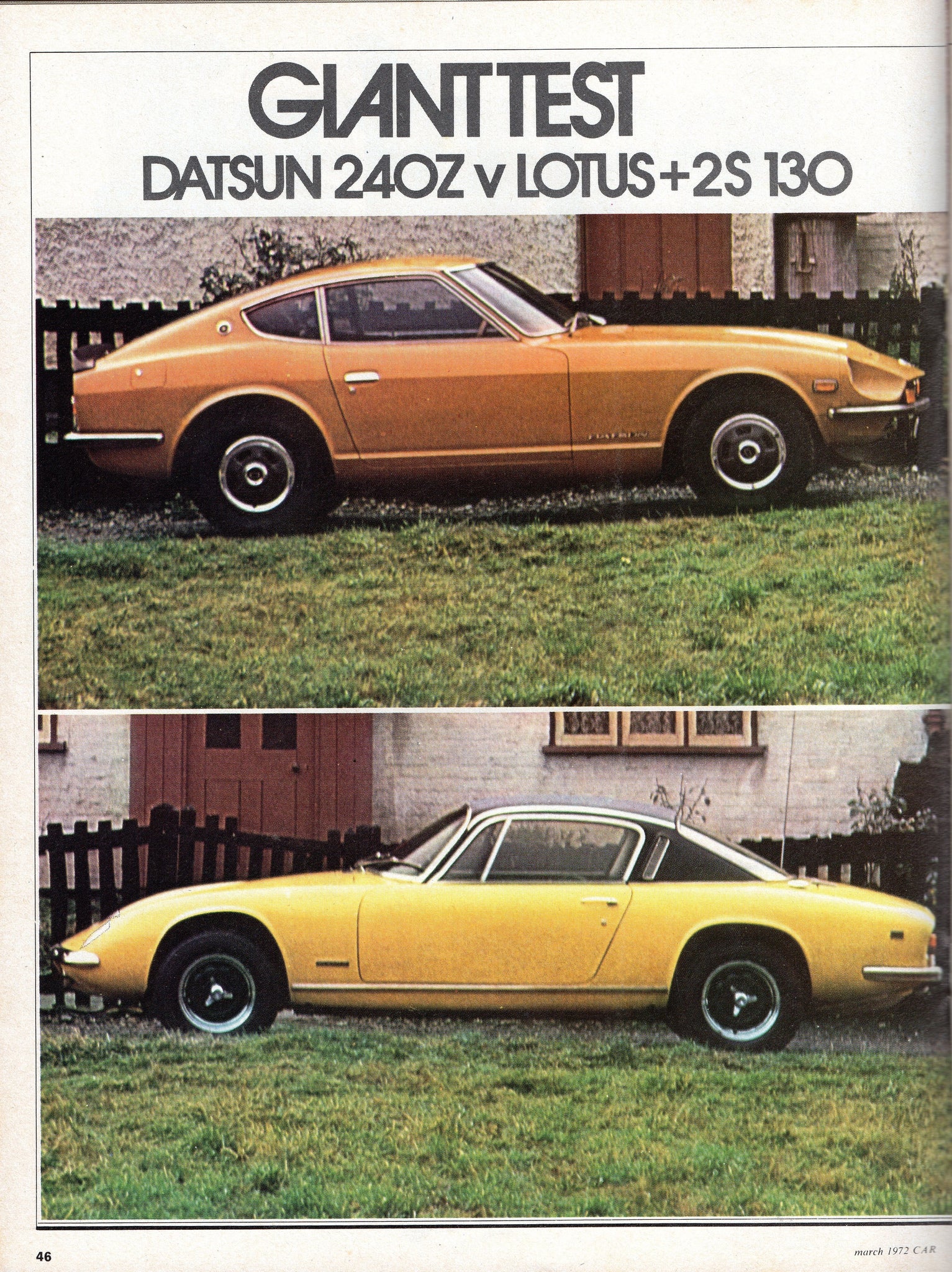
Here's a period review of the Datsun 240Z in the UK, and it gets a bit of a panning. That's somewhat to do with the pricing over here (~£1600 in the US vs ~£2400 in the UK). They didn't like the handling though, going so far as to say that if they tried this before the MGC they wouldn't have been so harsh on the latter car.
The first few sentences might offend most of the Americans here though :S
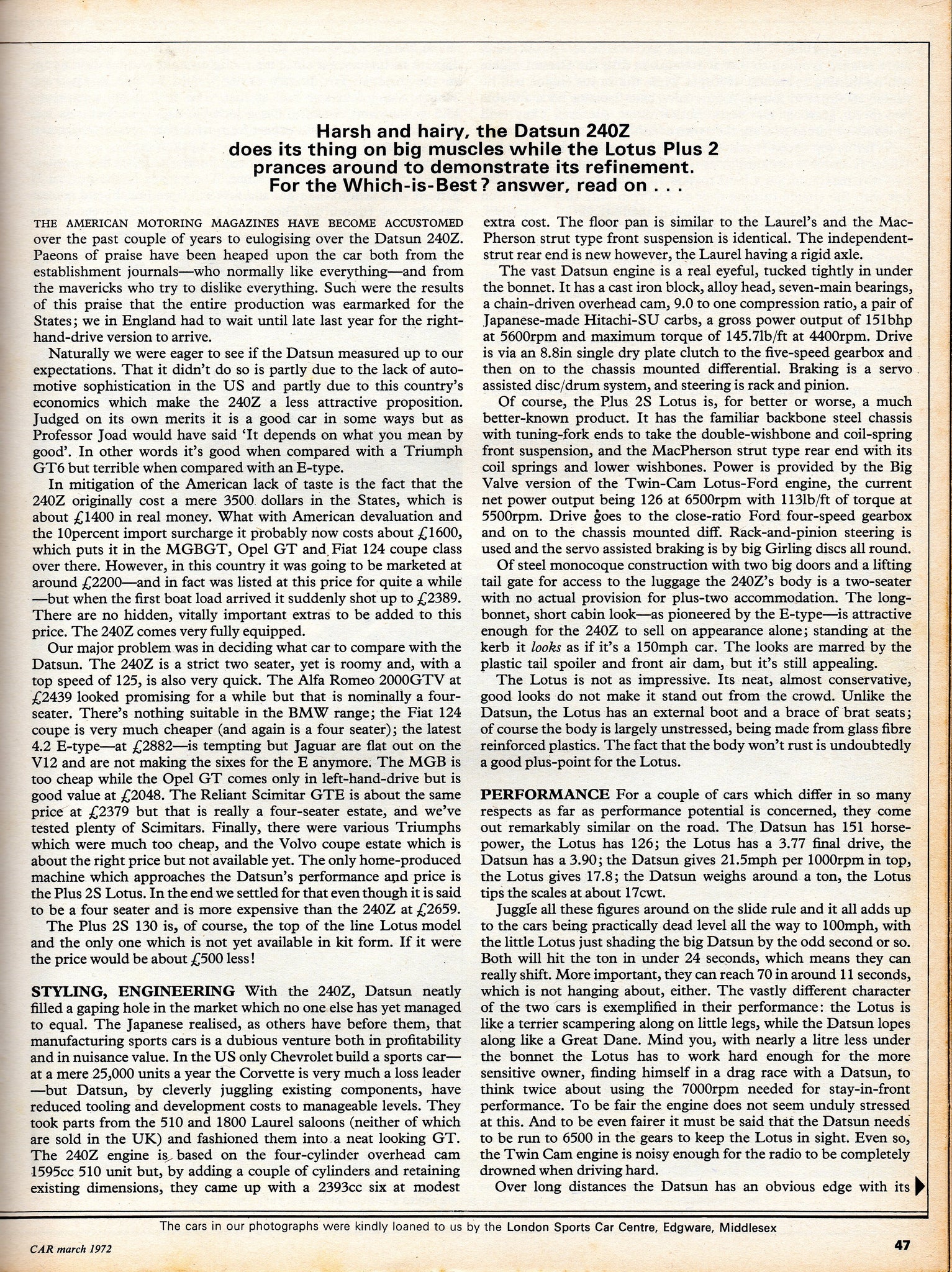
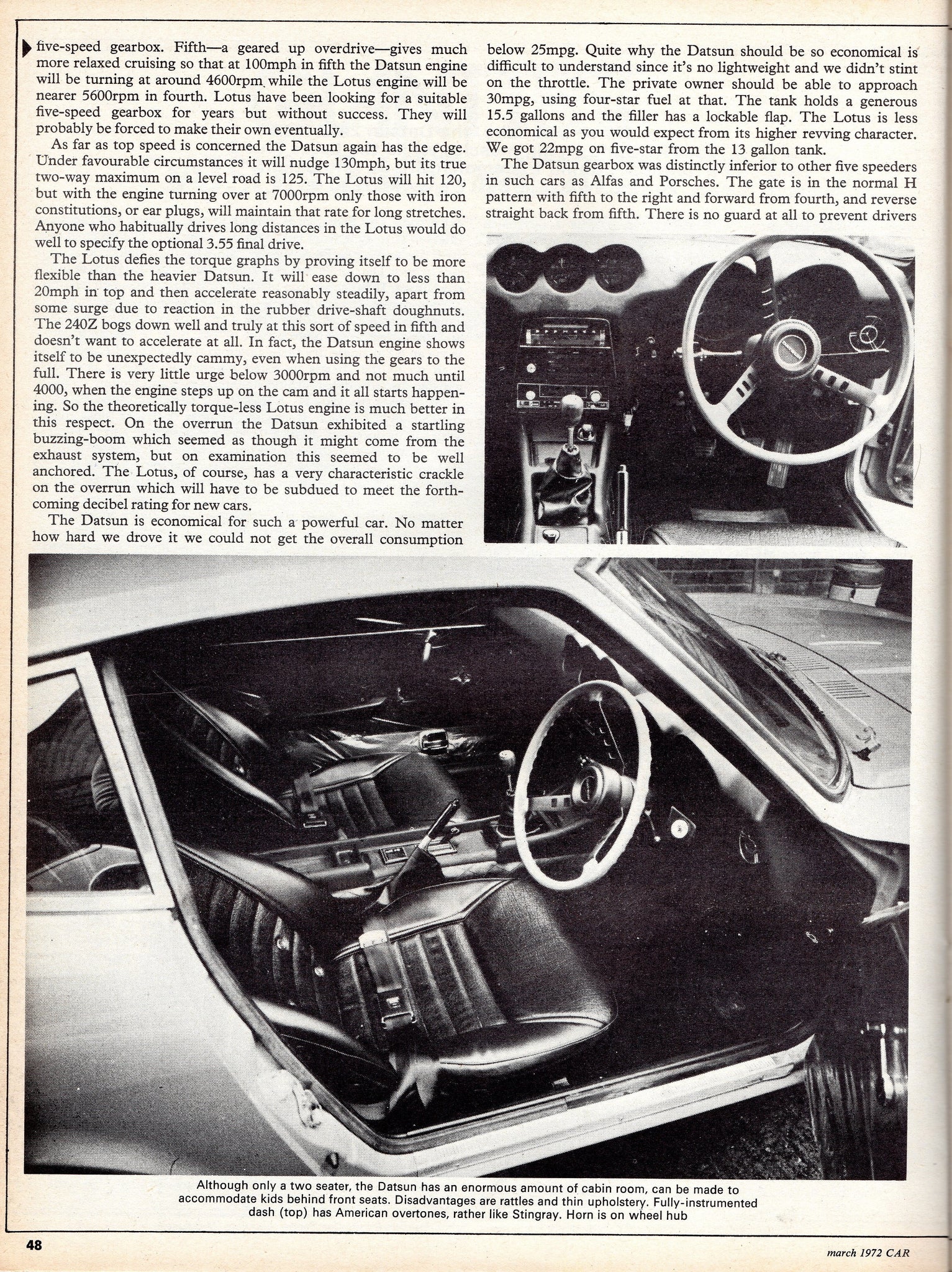
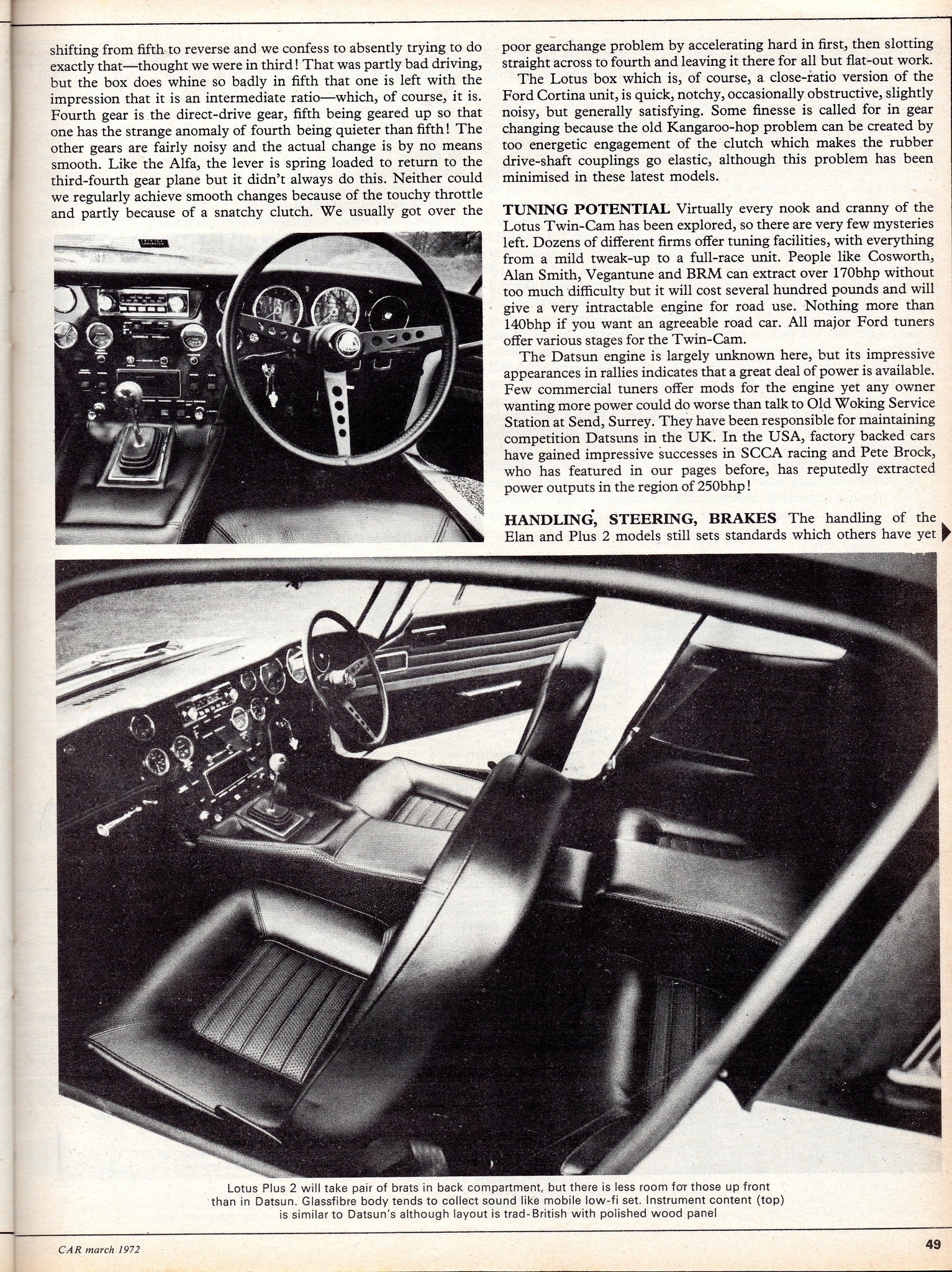
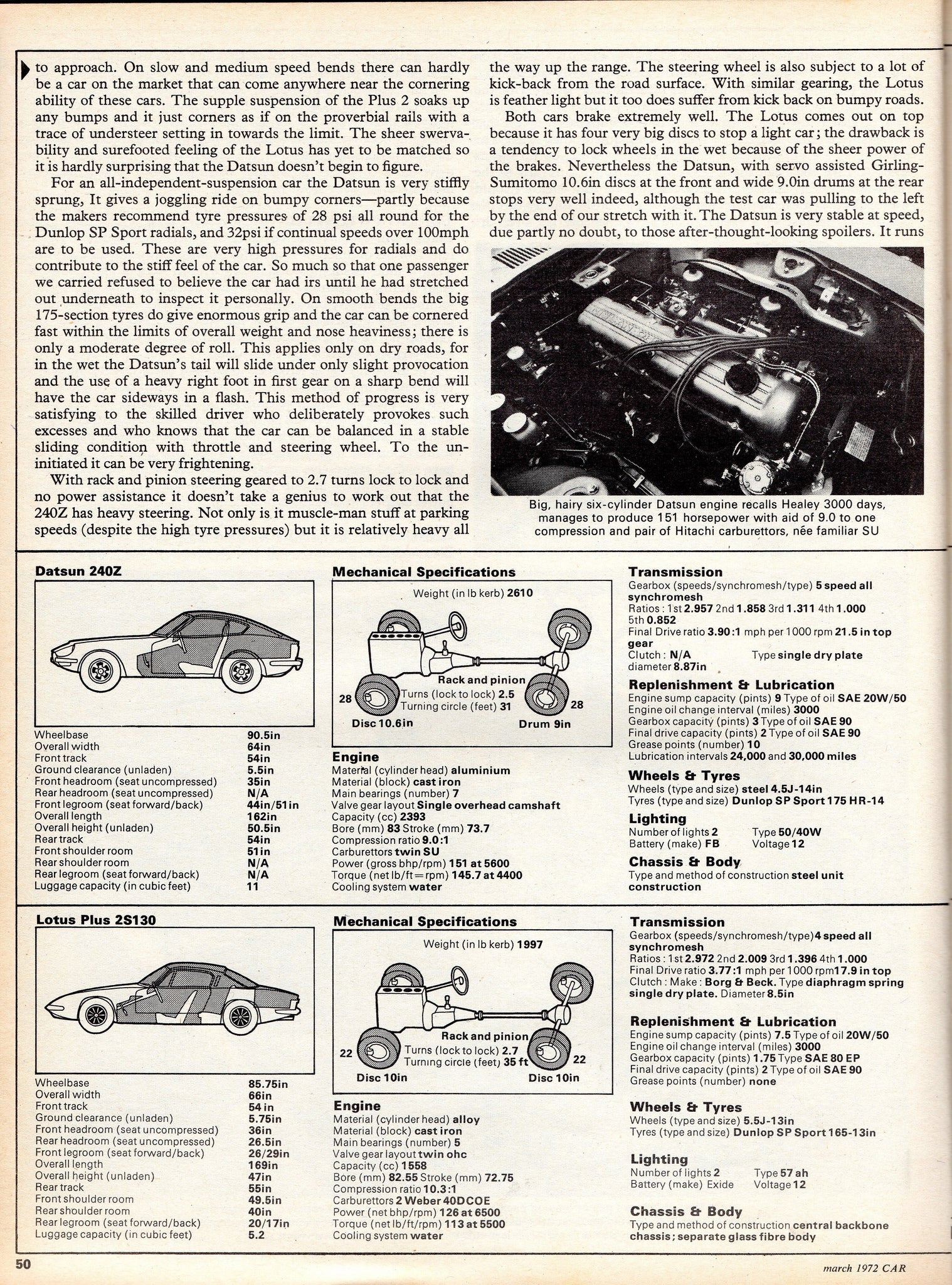
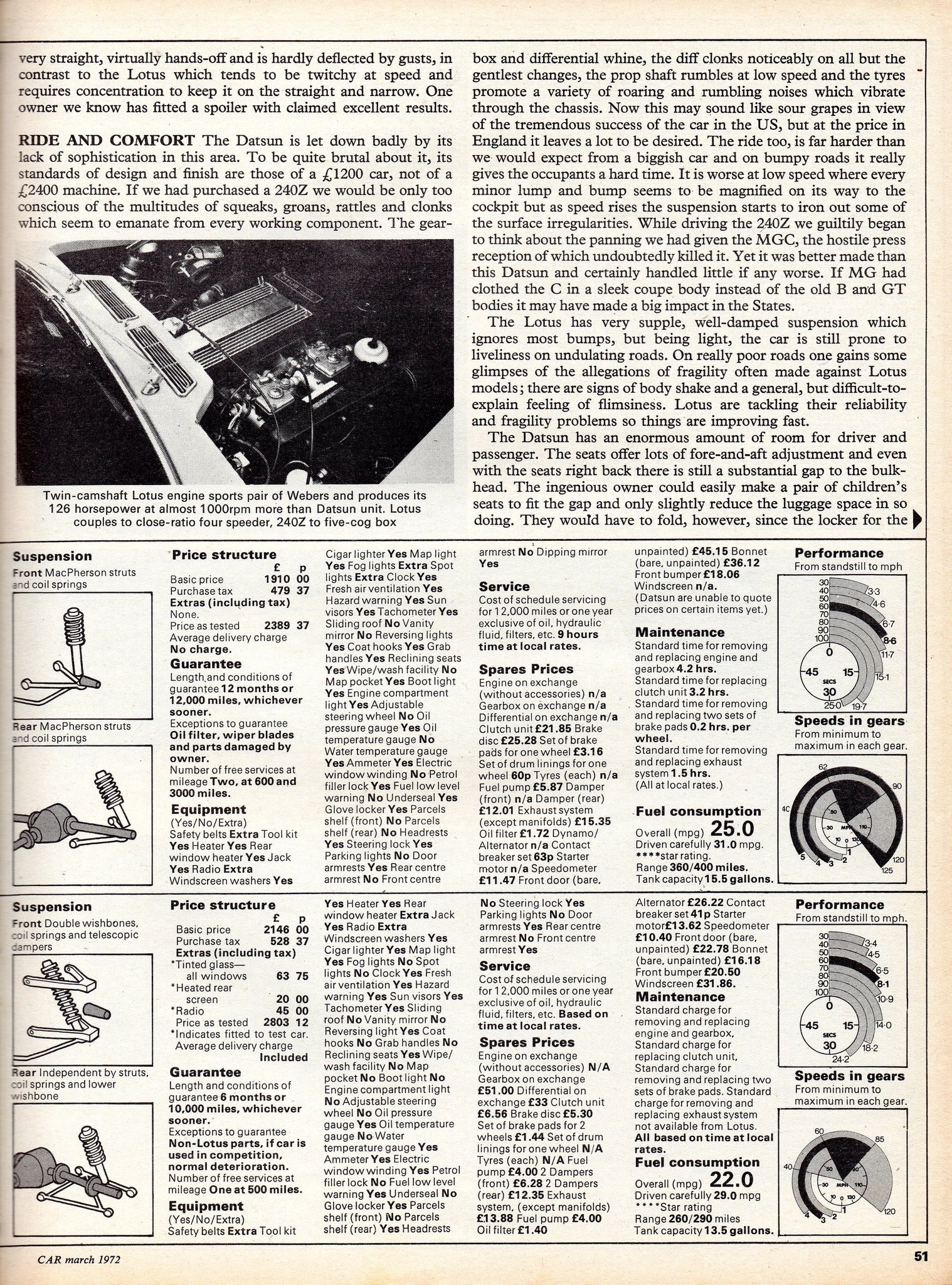
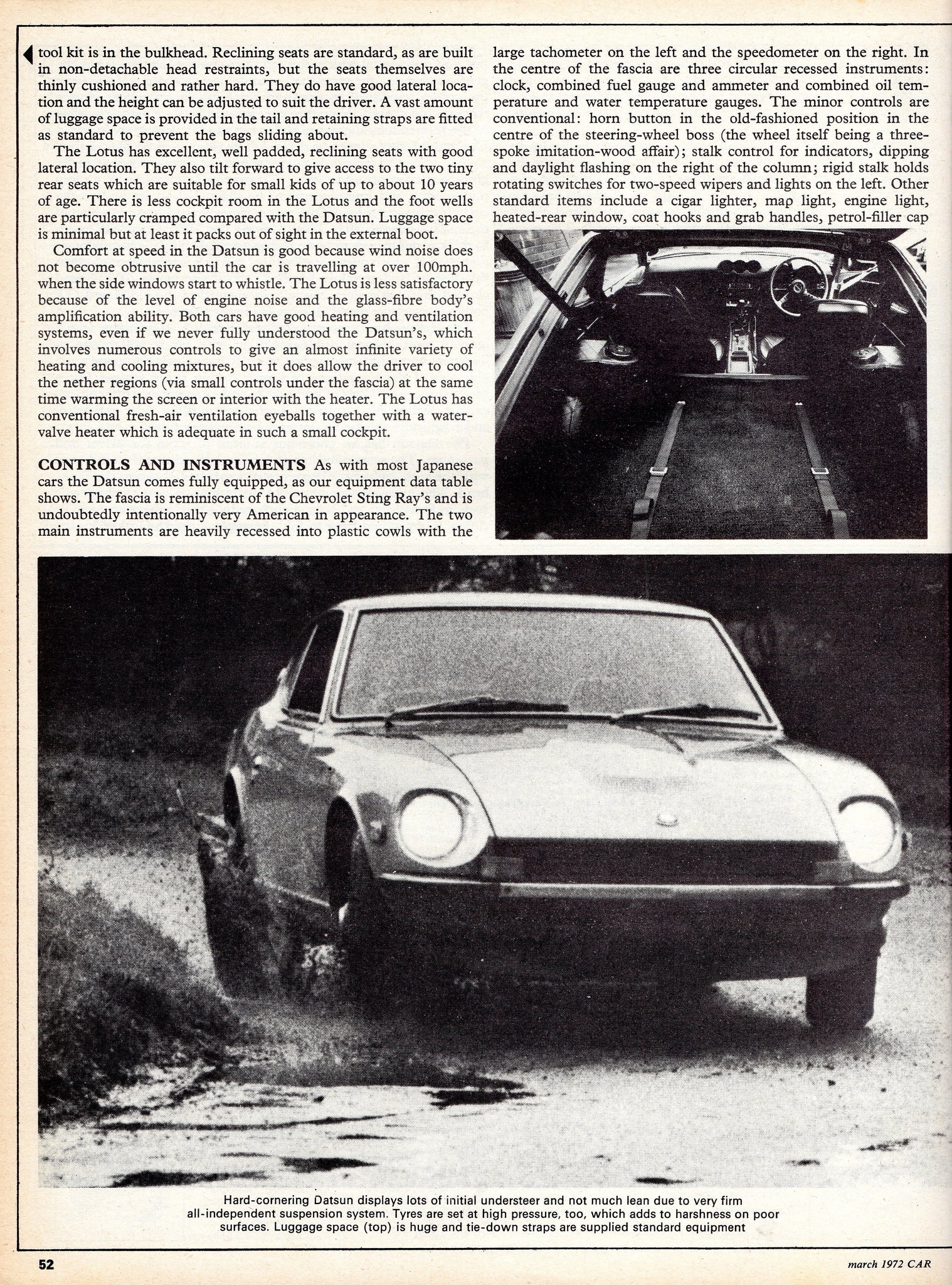
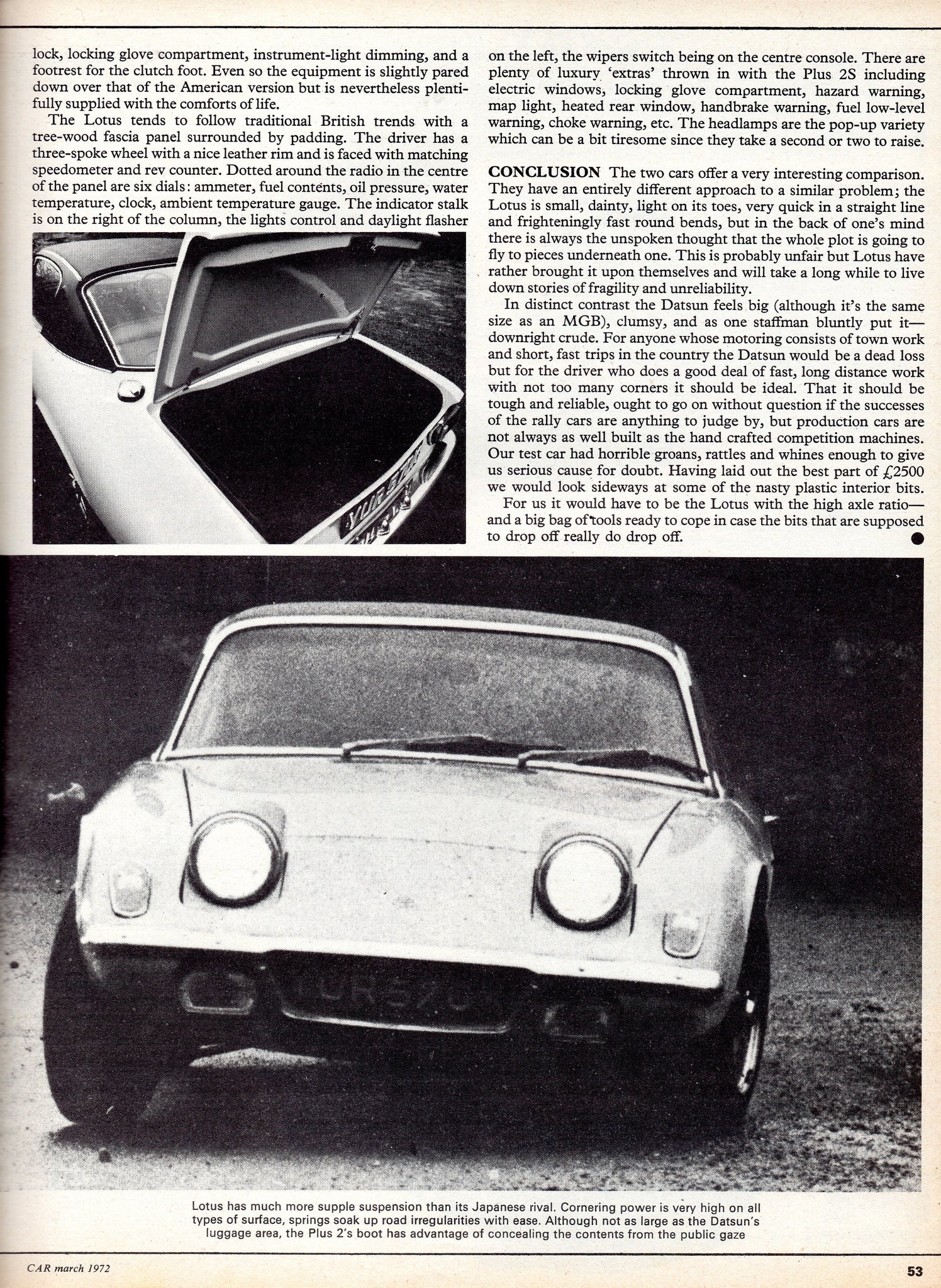
 bhardoin
> BiTurbo228 - Dr Frankenstein of Spitfires
bhardoin
> BiTurbo228 - Dr Frankenstein of Spitfires
03/08/2014 at 10:19 |
|
The British ones had firmer suspensions, like the ones in Japan - they softened up the US ride since we were all driving boats at that time. Price definitely hurts though.
 Goshen, formerly Darkcode
> BiTurbo228 - Dr Frankenstein of Spitfires
Goshen, formerly Darkcode
> BiTurbo228 - Dr Frankenstein of Spitfires
03/08/2014 at 10:19 |
|
Indeed the establishment journals normally like everything.
 BiTurbo228 - Dr Frankenstein of Spitfires
> bhardoin
BiTurbo228 - Dr Frankenstein of Spitfires
> bhardoin
03/08/2014 at 10:32 |
|
Ah, that might do it. I wonder how they'd have reacted to a US-spec 240. Probably a little more favourably.
 duurtlang
> BiTurbo228 - Dr Frankenstein of Spitfires
duurtlang
> BiTurbo228 - Dr Frankenstein of Spitfires
03/08/2014 at 11:22 |
|
Those first paragraphs did make me laugh.
 The Transporter
> BiTurbo228 - Dr Frankenstein of Spitfires
The Transporter
> BiTurbo228 - Dr Frankenstein of Spitfires
03/08/2014 at 11:57 |
|
You forgot to include the picture of the author that came with the review.

 John Norris (AngryDrifter)
> BiTurbo228 - Dr Frankenstein of Spitfires
John Norris (AngryDrifter)
> BiTurbo228 - Dr Frankenstein of Spitfires
03/08/2014 at 12:16 |
|
And the winner of the GIANT TEST is the 126HP car. If the author is still with us+ he needs to come back and apologize.
 BiTurbo228 - Dr Frankenstein of Spitfires
> The Transporter
BiTurbo228 - Dr Frankenstein of Spitfires
> The Transporter
03/08/2014 at 12:18 |
|
The yank-bashing does sound a bit Clarksonian doesn't it?
There might be some basis in fact though. As a rule, American roads are straighter and flatter than UK ones. Ours are very windy and bumpy as all hell.
That does tend to foster a different automotive landscape, and skew our tastes respectively.
 BiTurbo228 - Dr Frankenstein of Spitfires
> John Norris (AngryDrifter)
BiTurbo228 - Dr Frankenstein of Spitfires
> John Norris (AngryDrifter)
03/08/2014 at 12:22 |
|
A 126bhp 865kg car. That second figure is very important.
Also, the 150bhp figure for the Datsun is gross, and the 126bhp for the Lotus is net so in reality they're closer together than the figures suggest.
 GhostZ
> BiTurbo228 - Dr Frankenstein of Spitfires
GhostZ
> BiTurbo228 - Dr Frankenstein of Spitfires
03/08/2014 at 13:53 |
|
The 240Z had a 135 HP Net with twin SU carbs, and about 140HP net with triple Webers.
 BiTurbo228 - Dr Frankenstein of Spitfires
> GhostZ
BiTurbo228 - Dr Frankenstein of Spitfires
> GhostZ
03/08/2014 at 14:25 |
|
Ah, thankyou :) I've been trying to find that info for ages. I thought it'd be around the high 130s, but I didn't know for sure.
 GhostZ
> BiTurbo228 - Dr Frankenstein of Spitfires
GhostZ
> BiTurbo228 - Dr Frankenstein of Spitfires
03/08/2014 at 14:30 |
|
I remember a few dyno tests on a Z forum a while back that confirmed it. The numbers also work out.
Some of the very early Zs (early 1970-71) actually produced a little more than 140HP net due to higher-compression heads, making them the fastest of the S30s with proper tuning, but only ~10,000 were made.
Contrary to popular belief though, the 280ZX flattop engine was the most powerful non-turbo stock L engine, it just also came in the heaviest car.
 BiTurbo228 - Dr Frankenstein of Spitfires
> GhostZ
BiTurbo228 - Dr Frankenstein of Spitfires
> GhostZ
03/08/2014 at 14:50 |
|
It's good that someone's actually done some proper dynos to verify the results. A similar thing was done with the TR6 PI engine (pegged at 150bhp gross), and that came out as 141bhp net. Since then I've been trying to track down as many net figures as I can find for late 60s/early 70s cars. Mainly for this :)
I don't think I've got the 280ZX engine on there actually. Shall have to change that.
 BiTurbo228 - Dr Frankenstein of Spitfires
> GhostZ
BiTurbo228 - Dr Frankenstein of Spitfires
> GhostZ
03/08/2014 at 15:15 |
|
Oh, do you know what the 260Z and 280Z made net? I can't find anything reliable on those either.
 GhostZ
> BiTurbo228 - Dr Frankenstein of Spitfires
GhostZ
> BiTurbo228 - Dr Frankenstein of Spitfires
03/08/2014 at 15:36 |
|
The 260z wasn't significantly higher than the 240z (from what I can gather) but the 280Z made about 145HP net. It was rated as net from the factory. It was actually almost identical in power output to the early 280ZXs, until they switched to new heads and flattop pistons to get 150HP net.
 BiTurbo228 - Dr Frankenstein of Spitfires
> GhostZ
BiTurbo228 - Dr Frankenstein of Spitfires
> GhostZ
03/08/2014 at 15:36 |
|
Scratch that, found them. About 130bhp from the 260Z, 150 for the 280Z and 145 for the 280ZX apparently :)
 GhostZ
> BiTurbo228 - Dr Frankenstein of Spitfires
GhostZ
> BiTurbo228 - Dr Frankenstein of Spitfires
03/08/2014 at 15:42 |
|
If I can find the source, I'll send it your way, but it's generally close to these numbers:
'70-early '71: 135HP w/twin SU, 140 HP w/triple Webers
'71-73: 125HP w/twin SU, 130 HPw/triple webers
'74: 130HP / 135HP
'75-78: 140HP (fuel injection)
'79-'81: 145HP
'81-'83 Non turbo: 150HP net
I may be off by 3-5HP on some, but the gradient is about like that.
 GhostZ
> BiTurbo228 - Dr Frankenstein of Spitfires
GhostZ
> BiTurbo228 - Dr Frankenstein of Spitfires
03/08/2014 at 15:49 |
|
Ironically, that is almost EXACTLY what I was just posted before seeing this comment. I think the estimation for the 280Z is a bit high, the 280ZX had much improved heads, cooling, etc. on the engine and otherwise the same basic components. However, the 280Z numbers may have been quote without the air conditioning system hooked up, which was standard on 280ZXs.
 GhostZ
> BiTurbo228 - Dr Frankenstein of Spitfires
GhostZ
> BiTurbo228 - Dr Frankenstein of Spitfires
03/08/2014 at 15:55 |
|
Redlines for the 260Z, 280Z and 280ZX were (factory "yellow zone") 6400 and in actuality (true redline) just under 7000. The 240z (which had the shorter stroke) was higher.
 BiTurbo228 - Dr Frankenstein of Spitfires
> GhostZ
BiTurbo228 - Dr Frankenstein of Spitfires
> GhostZ
03/08/2014 at 16:42 |
|
I spotted that. The info I got for the 280Z was 120.9bhp at the wheels, with a 25% increase for crank hp. They also had whp figures for the 240Z and 260Z, and adding the same 25% came to within a horse power of the other figures you've given :)
I've also been reading up on different ways of measureing bhp, and if the 280ZX was done to SAE net hp they would have been forced to run the A/C if it was standard fitment, so that does sound likely.
Which means, if you've got a 280ZX with air con, simply taking it off could net a 10hp increase or so :) better still if there's a disconnect button for the compressor
 BiTurbo228 - Dr Frankenstein of Spitfires
> GhostZ
BiTurbo228 - Dr Frankenstein of Spitfires
> GhostZ
03/08/2014 at 16:43 |
|
Do you reckon they could reach a genuine 7000 or 6750?
 GhostZ
> BiTurbo228 - Dr Frankenstein of Spitfires
GhostZ
> BiTurbo228 - Dr Frankenstein of Spitfires
03/08/2014 at 16:58 |
|
Easily. Rebello race engines hit 10,000rpms, and properly balanced/built engines can hit 8000rpm on a stock crank. They really have a lot more RPM to give than they had at stock. It takes a new cam, intake, etc. to reach those higher RPMs and better cooling. Nissan kept the redlines low for reliability's sake.
For example, the mythical OS Giken DOHC heads used the same crank, pistons, and block and would rev to 11000 and make 300+HP on the same engine's bottom end. Good luck finding one for under $50,000 though.
 GhostZ
> BiTurbo228 - Dr Frankenstein of Spitfires
GhostZ
> BiTurbo228 - Dr Frankenstein of Spitfires
03/08/2014 at 17:03 |
|
The 280Z had a different transmission, driveshaft, and rear differential from the 260z or the 240z, I don't know if drag was higher or lower though. Would be interesting to find out.
 BiTurbo228 - Dr Frankenstein of Spitfires
> GhostZ
BiTurbo228 - Dr Frankenstein of Spitfires
> GhostZ
03/08/2014 at 17:11 |
|
Yes it would :) what we really need is someone with both cars, a dyno and a ton of spare time
 BiTurbo228 - Dr Frankenstein of Spitfires
> GhostZ
BiTurbo228 - Dr Frankenstein of Spitfires
> GhostZ
03/08/2014 at 17:15 |
|
I've encountered the OS Giken engines on Speedhunters. Mental engines :) I've heard he's started making them again recently.
The max rpm is more what can be safely achieved on a bone-stock engine.
Actually, something else you might know. What's the biggest displacement you've heard of for an l-series? Can be modified as heavily as you like, bar the creation of an entirely new block.
 GhostZ
> BiTurbo228 - Dr Frankenstein of Spitfires
GhostZ
> BiTurbo228 - Dr Frankenstein of Spitfires
03/08/2014 at 17:29 |
|
Nissan made a diesel crankshaft for the LD28 that has a longer stroke (83mm) and if you bore the L28 block 3 mm over (which is possible on a cast iron block, but may require sleeves) to a bore of 89mm, you can use aftermarket KA24-sized pistons. This makes for an engine of 3098cc and a compression ratio of about 9:1 depending on which connecting rod you use. THAT is the most realistic bore/stroke maximum.
However, if you go with custom crank, pistons, and block sleeves, you can get a 89 x 86 mm engine (+3mm stroke over the LD28) for 3197cc. which is close to what Rebello gets I believe. I've never seen an engine over 3.3 liters, and bore is usually the limiting factor (as it is on many straight-6 engines). I've never seen one hit 3.3l (which necessitates an EVEN LONGER stroke) and last for very long.
 GhostZ
> BiTurbo228 - Dr Frankenstein of Spitfires
GhostZ
> BiTurbo228 - Dr Frankenstein of Spitfires
03/08/2014 at 17:37 |
|
Oh, and in my experience, you can run an L engine up and down 7000RPM and not worry, they're extremely limited by intake and cam choices, not by the strength of the block or internals, which are all good for about 300HP. Yes. I am not joking, Nissan built the internals to handle about twice as much power as they actually produce.
 BiTurbo228 - Dr Frankenstein of Spitfires
> GhostZ
BiTurbo228 - Dr Frankenstein of Spitfires
> GhostZ
03/08/2014 at 18:36 |
|
That's probably part of the reason why they don't fall apart as readily as the established Brits at the time :)
 BiTurbo228 - Dr Frankenstein of Spitfires
> GhostZ
BiTurbo228 - Dr Frankenstein of Spitfires
> GhostZ
03/08/2014 at 19:06 |
|
Thanks man, so realistically 3.2l is the usable max.
It's mainly to compare how much displacement you can get from an engine compared to the weight. It's things like the weight of an LS vs the weight of a Jaguar V12. Both 5.3l, but one is nearly twice the weight of the other.
Then you realise the V12 can be bored and stroked to a shade over 10 litres. That goes some way to explain the weight difference :)
Also, the Alfa V6 seems pretty damn heavy for a 2.5l all-alloy engine, especially compared to the 2.5l M20B25 cast-iron block BMW I6. However, the Alfa V6 can be punched out to 3.8l using a stock crank, whereas the BMW can only hit 2.7l as far as I can tell.
 bhardoin
> BiTurbo228 - Dr Frankenstein of Spitfires
bhardoin
> BiTurbo228 - Dr Frankenstein of Spitfires
03/08/2014 at 19:44 |
|
Yeah. Or being British, they may have quipped about the lack of sportiness, and still favored the local motor. haha
 BiTurbo228 - Dr Frankenstein of Spitfires
> bhardoin
BiTurbo228 - Dr Frankenstein of Spitfires
> bhardoin
03/08/2014 at 19:52 |
|
There is probably a lot of that, although they were universally damning to the MGC. That was even before the national sport of BL-bashing got into full swing :)
 Bubbles22
> The Transporter
Bubbles22
> The Transporter
03/08/2014 at 23:30 |
|
Young girls wrote for UK car mags in the early 70's? Very progressive.
 Sunray09
> The Transporter
Sunray09
> The Transporter
03/09/2014 at 16:29 |
|
So why the long face Mr Clarkson?